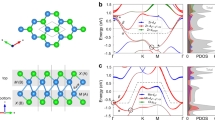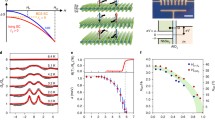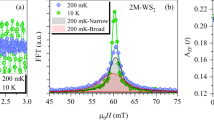Abstract
Nb2S2C is a van der Waals type layered superconductor with a transition temperature Tc = 7.6 K. In this paper, detailed calculations of the electronic structure and topological properties of Nb2S2C were performed from first principles. We find that Nb2S2C is a highly anisotropic metal with multi-band characteristics. In the absence of spin–orbit coupling (SOC), there appears one pair of triply degenerate points created by band inversion along the Γ–A line. When SOC is considered, the triple points are gapped. Intriguingly, two distinct types of topological states, including topological Dirac semimetal and topological insulator states, co-emergence in the vicinity of Fermi level. Moreover, the topology of Nb2S2C is robust to external pressure and the Fermi level can be shifted downward to the topological Dirac semimetal state and topological insulator state at 10 GPa and 14 GPa, respectively. The results herein provide a new platform not only for the studies of physics of low-dimensional superconductor but also for further investigations of topological superconductivity.
Similar content being viewed by others
Avoid common mistakes on your manuscript.
1 Introduction
Superconductors in van der Waals structure have attracted extensive interest because they provide a new possibility for realizing highly crystalline two-dimensional (2D) superconducting systems with exotic properties that differ from the bulk [1,2,3,4,5,6,7,8,9,10,11]. For instance, atomically thin NbSe2 crystals have been discovered to host unusual superconducting states, including Ising superconductivity with a strong in-plane upper critical field [3] and a field-induced Bose-metal phase under the out-of-plane magnetic field [4]. Therefore, exploring new quasi-2D superconductors is one of the most intriguing themes in the field of condensed matter physics [9, 10].
Our title compound, Nb2S2C, has been already synthesized in 1992 [12] and discovered as a superconductor in 2001 [13]. Below Tc = 7.6 K, Nb2S2C exhibits type-II bulk superconductivity. Because Nb2S2C could not be prepared by direct synthesis, its physical properties hence have been scarcely studied [13, 14]. However, its van der Waals type layered structure, endows Nb2S2C with a promising candidate for realizing a new 2D superconductor. Therefore, investigation on Nb2S2C in terms of the electronic structure is very valuable.
In this paper, using first-principles calculations, we predict the coexistence of topological Dirac semimetal and topological insulator states in the vicinity of Fermi level (Ef) in the bulk electronic band structure of Nb2S2C. Because the interplay of non-trivial band topology and superconductivity may give rise to topological superconductivity hosting the long pursuing Majorana fermion, which is potential for the use in low decoherence topological quantum computation [15,16,17], Nb2S2C as such provides a new platform not only for the studies of physics of 2D superconductor but also for further investigations of topological superconductivity.
2 Computational methodology
Present first-principles calculations were carried out within the framework of the projector augmented wave (PAW) method [18], and employed the generalized gradient approximation (GGA) with Perdew–Burke–Ernzerhof (PBE) formula [19], as implemented in the Vienna Ab initio Simulation Package (VASP) [20, 21]. The DFT-D2 method was adopted to describe the weak interactions [22]. A kinetic energy cutoff of 500 eV and a Γ-centered k mesh of 15 × 15 × 7 were utilized in all calculations. The energy and force difference criterion were defined as 10–6 eV and 0.1 eV·nm−1 for self-consistent convergence and structural relaxation. The Wannier90 package [23,24,25] was adopted to construct Wannier functions from the first principles results without an iterative maximal-localization procedure. The WannierTools code [26] was used to investigate the topological features of surface state spectra.
3 Results and discussion
The crystal structure of Nb2S2C is shown in Fig. 1a. Nb2S2C occurs in a layered structure described by the hexagonal space group P-3 m1 (No. 164) [12]. It consists of five atomic layers stacked in a sequence of S–Nb–C–Nb–S. The quintuple-layer in bulk Nb2S2C is weakly coupled by van der Waals interaction. The structural parameters of bulk Nb2S2C calculated by PBE and PBE-D2 methods are listed in Table 1 and compared with experimental data. It can be seen from Table 1 that the optimized lattice constants are in reasonable agreement with experimental values when the van der Waals interaction is considered by the PBE-D2 method. In contrast, the PBE method significantly overestimates the lattice parameter constant c, implying an importance of the van der Waals interaction in Nb2S2C. Table 1 also shows that the effect of the van der Waals interaction is negligible on the thickness of the Nb2S2C layer. We use the lattice parameters optimized by PBE-D2 method in the following calculations. Figure 1b shows the bulk Brillouin zone (BZ), projected (001) and (010) surface BZ, and high symmetry points.
The calculated electronic density of states (DOS) along with atomic projected DOS, plotted in Fig. 2a, shows finite DOS at the Ef, thus revealing metallic behavior for Nb2S2C. The Nb-4d and S-3p orbitals are widely distributed over all energies below and above the Ef and dominate the low-energy states of Nb2S2C. The C-2p derived states primarily lie 3.5 eV below the Ef. Since the DOS at the Ef has contributions largely from Nb-4d and S-3p states, we thus can emphasize that Nb-4d and S-3p electrons are most efficient in developing the superconducting properties of Nb2S2C.
Figure 2b shows the DFT result of the electronic band structure in the absence of SOC. There are three bands crossing the Ef, indicating a feature of multi-band superconductivity. The dominant feature of the band is that it shows highly anisotropic dispersion, as expected. The band is highly dispersive along with the in-plane directions, whereas its dispersion is quite small along the out-of-plane direction. The large difference in the dispersions indicates a quasi 2D character of this superconducting system. Intriguingly, there is a triply degenerate band crossing point energy at 0.15 eV below the Ef along the Γ–A direction. This crossing point is formed by one doubly degenerate band and one nondegenerate band. The orbital projected band structures presented in Fig. 2c, d reveal that the doubly degenerate band is predominantly attributed to Si-3pxy orbitals and the nondegenerate band is mainly contributed by Nb-4dz2 states.
We next calculated the band structure of Nb2S2C in the presence of SOC, as shown in Fig. 3a. The inclusion of SOC does not have a significant effect on the overall band dispersions. It does effect on the band crossing point along the Γ–A direction. Upon including SOC, the original triple point is broken. Figure 3b shows the enlarged view of the band structure near the Ef along the Γ–A direction. There still exists a band crossing point formed by two bands with different irreducible representations (∆4 and ∆5+6). Because of the coexistence of inversion and time-reversal symmetries, all the bands are doubly degenerate [27]. This crossing point as such is fourfold degenerate. Because the Γ–A direction preserves the C3 rotational symmetry, this crossing point is symmetry protected against hybridization [28]. Around this crossing point, the related bands display linear dispersion along both in-plane and out-of-plane directions, as shown in Figs. 3c, e. Therefore, this crossing point is Dirac point. According to our calculations, there exists a pair of symmetry-protected Dirac points located at BZ coordinates \(\left( {0,{ }0,{ }k_{{\text{z}}}^{{\text{D}}} \approx \pm { }0.199 \times \frac{2\pi }{c}} \right)\) and energy ED—Ef = −0.113 eV. In addition to Dirac states, SOC also induces hybridization between two ∆4 bands and opens a gap of about 30 meV, leading to topological insulator (TI) states in the Γ–A line, see in Fig. 3b. Because SOC creates a band gap between the two ∆4 bands at each k point, we thus can define a Z2 invariant by assuming a curved Fermi level between the two ∆4 bands to characterize the band topology of Nb2S2C. Using the Wilson loop method [29], we calculate the topological invariant Z2. The Wannier charge center (WCC) evolution on the time-reversal invariant planes of Nb2S2C is shown in Fig. 4, from which we find Z2 = (1; 001), indicating the nontriviality of the band gap.
a Electronic band structure of Nb2S2C with considering SOC. b Enlarged view of the solid red area in a. c Two-dimensional band structure around the Dirac node in kx–kz plane. d Electronic band structure in kx–ky plane surrounding the Dirac point. e Two-dimensional band structure around the Dirac node in kx–ky plane
Exotic topological surface states are an important property to identify various topological phases [30, 31]. Figure 5 shows the calculated surface states on the (001) and (010) projected surfaces. On the (001) surface, a pair of bulk Dirac points on the kz axis are projected onto the same \(\overline{\Gamma }\) point, as indicated by the red dot in Fig. 5a. Topological surface states (denoted as SS1) originating from the projection of bulk Dirac points are clearly observed in the inset of Fig. 5a. In addition, a Dirac-cone surface state (denoted as SS2) appears inside the topological insulator gap. For the (010) surface, the pair of bulk Dirac points are projected onto the \(\tilde{\Gamma } - \tilde{Z}\) surface direction, as indicated by the red dot in Fig. 5b. A surface Dirac cone at the \(\tilde{\Gamma }\) point is observed, which is a signal of nontrivial band topology. This surface Dirac cone has its branches merging into the bulk states at the projection of three-dimensional (3D) Dirac point. It should be noted that this surface Dirac cone is distinct to the SS2 on the (001) surface, even though both of them disperse in the same energy range of − 0.2 to − 0.1 eV. This is because the surface state configuration depends on the details of the surface termination. These surface states obtained on both (001) and (010) surfaces are expected to be observed by angle-resolved photoemission spectroscopy (ARPES).
Considering that the van der Waals type crystal structure of Nb2S2C, external pressure is expected to be an effective and clean way to modulate its electronic structure. To showcase the effect of external pressure on the electronic structure of Nb2S2C, we carried out calculations of Nb2S2C under hydrostatic pressure. In Fig. 6a, b, we present our calculated lattice constants as a function of hydrostatic pressure. Lattice parameters a and c both gradually decrease with the increasing pressure, as expected. Figure 6d, e presents the band structures of Nb2S2C at 10 GPa and 14 GPa, respectively. Compared with the band structure at ambient pressure (Fig. 6c), we find that the electron Fermi pockets around the Γ point and along the Γ–K (Γ–K´) line disappear when applied pressure larger than 10 GPa, as indicated by the black arrows. Importantly, the bulk Dirac points can be shifted upward to the Ef at 10 GPa. Increasing pressure up to 14 GPa, the Ef is lowered into the bulk topological insulator gap. Therefore, it will be interesting to study the effect of pressure on the superconducting behavior and transport properties of Nb2S2C.
4 Conclusion
In conclusion, we have presented the results of first-principles calculations on electronic structure and topological properties for superconductor Nb2S2C. We predict that Nb2S2C is a topological metal hosting topological Dirac semimetal and topological insulator states. The Dirac points are derived from band inversion and protected by C3 rotational symmetry. The nontrivial surface states are obtained on both (001) and (010) surfaces. Further calculations of external pressure effects suggest the topology of Nb2S2C is robust to external pressure. Interestingly, Nb2S2C has a van der Waals-type layered structure, it thus provides a new platform to experimentally explore low dimensional superconductor and the interactions between superconductivity and multiple nontrivial topological states.
References
Saito Y, Nojima T, Iwasa Y. Highly crystalline 2D superconductors. Nat Rev Mater. 2017;2:16094.
Xi X, Zhao L, Wang Z, Berger H, Forró L, Shan J, Mak FK. Strongly enhanced charge-densitywave order in monolayer NbSe2. Nat Nanotechnol. 2015;10:765.
Xi X, Wang Z, Zhao W, Park JH, Law KT, Berger H, Forró L, Shan J, Mak KF. Ising pairing in superconducting NbSe2 atomic layers. Nat Phys. 2016;12:139.
Tsen AW, Hunt B, Kim YD, Yuan ZJ, Jia S, Cava RJ, Hone J, Kim P, Dean CR, Pasupathy AN. Nature of the quantum metal in a two-dimensional crystalline superconductor. Nat Phys. 2016;12:208.
Arguilla MQ, Katoch J, Krymowski K, Krymowski ND, Xu J, Xi X, Hanks A, Jiang S, Ross RD, Koch RJ, Ulstrup S, Bostwick A, Jozwiak C, McComb DW, Rotenberg E, Shan J, Windl W, Kawakami RK, Goldberger JE. NaSn2As2: an exfoliatable layered van der waals zintl phase. ACS Nano. 2016;10:9500.
Goto Y, Yamada A, Matsuda TD, Aoki Y, Mizuguchi Y. SnAs-based layered superconductor NaSn2As2. J Phys Soc Jpn. 2017;86:123701.
Kim JS. A new van der Waals type superconductor. JPSJ News Comments. 2017;14:13.
Ishihara K, Takenaka T, Miao Y, Tanaka O, Mizukami Y, Usui H, Kuroki K, Konczykowski M, Goto Y, Mizuguchi Y, Shibauchi T. Evidence for s-wave pairing with atomic scale disorder in the van der Waals superconductor NaSn2As2. Phys Rev B. 2018;98:020503(R).
Cheng EJ, Ni JM, Meng FQ, Ying TP, Pan BL, Huang YY, Peets DC, Zhang QH, Li SY. Nodeless superconductivity in the SnAs-based van der Waals-type superconductor NaSn2As2. Europhys Lett. 2018;123:47004.
Li YL, Stavrou E, Zhu Q, Clarke SM, Li Y, Huang HM. Superconductivity in the van der Waals Layered Compound PS2. Phys Rev B. 2019;99:220503(R).
Parvin F, Naqib SH. Pressure dependence of structural, elastic, electronic, thermodynamic, and optical properties of van der Waals-type NaSn2P2 pnictide superconductor: Insights from DFT study. Results Phys. 2021;21:103848.
Boller H, Hiebl K. Quaternary pseudo-intercalation phases Tx [Nb2S2C] (T ≡ V, Cr, Mn, Fe Co, Ni, Cu) and metastable Nb2S2C formed by topochemical synthesis. J Alloys Compd. 1992;183:438.
Sakamaki K, Wada H, Nozaki H, Onuki Y, Kawai M. van der Waals type carbosulfide superconductor. Solid State Commun. 2001;118:113.
Sakamaki K, Wada H, Nozaki H, Onuki Y, Kawai M. Topochemical formation of van der Waals type niobium carbosulfide 1T-Nb2S2C. J Alloys Compd. 2002;339:283.
Xia W, Shi X, Zhang Y, Su H, Wang Q, Ding L, Chen L, Wang X, Zou Z, Yu N, Pi L, Hao Y, Li B, Zhu Z, Zhao W, Kou X, Guo Y. Bulk Fermi surface of the layered superconductor TaSe3 with three-dimensional strong topological state. Phys Rev B. 2020;101:155117.
Zhang G, Shi X, Liu X, Xia W, Su H, Chen L, Wang X, Yu N, Zou Z, Zhao W, Guo Y. de Haas-van Alphen quantum oscillations in BaSn3 superconductor with multiple dirac fermions. Chin Phys Lett. 2020;37:087101.
Huang Z, Shi X, Zhang G, Liu Z, Cho S, Jiang Z, Liu Z, Liu J, Yang Y, Xia W, Zhao W, Guo Y, Shen D. Photoemission spectroscopic evidence of multiple dirac cones in superconducting BaSn3. Chin Phys Lett. 2021;38:107403.
Blöchl PE. Projector augmented-wave method. Phys Rev B. 1994;50:17953.
Perdew JP, Burke K, Ernzerhof M. Generalized gradient approximation made simple. Phys Rev Lett. 1996;77:3865.
Kresse G, Hafner J. Ab initio molecular-dynamics simulation of the liquid-metal-amorphoussemiconductor transition in germanium. Phys Rev B. 1994;49:14251.
Kresse G, Furthmüller J. Efficient iterative schemes for ab initio total-energy calculations using a plane-wave basis set. Phys Rev B. 1996;54:11169.
Grimme S. Semiempirical GGA-type density functional constructed with a long-range dispersion correction. J Comput Chem. 2006;85:1787.
Mostofi AA, Yates JR, Lee Y-S, Souza I, Vanderbilt D, Marzari N. wannier90: a tool for obtaining maximally-localised Wannier functions. Comput Phys Commun. 2008;178:685.
Marzari N, Vanderbilt D. Maximally localized generalized Wannier functions for composite energy bands. Phys Rev B. 1997;56:12847.
Souza I, Marzari N, Vanderbilt D. Maximally localized Wannier functions for entangled energy bands. Phys Rev B. 2001;65:035109.
Wu QS, Zhang SN, Song HF, Troyer M, Soluyanov AA. WannierTools: an open-source software package for novel topological materials. Comput Phys Commun. 2018;224:405.
Weng H, Liang Y, Xu Q, Yu R, Fang Z, Dai X, Kawazoe Y. Topological node-line semimetal in three-dimensional graphene networks. Phys Rev B. 2015;92:045108.
Yang BJ, Nagaosa N. Classification of stable three-dimensional Dirac semimetals with nontrivial topology. Nat Commun. 2014;5:4898.
Yu R, Qi XL, Bernevig A, Fang Z, Dai X. Equivalent expression of Z2 topological invariant for band insulators using the non-Abelian Berry connection. Phys Rev B. 2011;84:075119.
Wang Z, Sun Y, Chen X-Q, Franchini C, Xu G, Weng H, Dai X, Fang Z. Dirac semimetal and topological phase transitions in A3Bi (A = Na, K, Rb). Phys Rev B. 2012;85:195320.
Wang Z, Weng H, Wu Q, Dai X, Fang Z. Three-dimensional Dirac semimetal and quantum transport in Cd3As2. Phys Rev B. 2013;88:125427.
Acknowledgements
This work was supported by the Natural Science Foundation of China (Grant No. 52073075), Shenzhen Science and Technology Program (Grant No. KQTD20170809110344233), and Science and Technology Innovation Talents Program of Henan Province (Grant No. 174200510010).
Author information
Authors and Affiliations
Corresponding authors
Ethics declarations
Conflict of interest
The authors declare no conflict of interest.
Additional information
Publisher's Note
Springer Nature remains neutral with regard to jurisdictional claims in published maps and institutional affiliations.
Rights and permissions
About this article
Cite this article
Shi, XB., He, P. & Zhao, WW. Dual topology in van der Waals-type superconductor Nb2S2C. Tungsten 5, 357–363 (2023). https://doi.org/10.1007/s42864-022-00135-8
Received:
Revised:
Accepted:
Published:
Issue Date:
DOI: https://doi.org/10.1007/s42864-022-00135-8










